-
Posts
2,406 -
Joined
-
Last visited
Content Type
Profiles
Forums
Gallery
Events
Articles
Posts posted by Ian
-
-
Ditto what bill and elverno said.
 beautiful coins.
beautiful coins.So why does the city of Nancy figure a thistle so prominently on its coat of arms? just wondering...
Interesting question indeed, and one that got me asking the same thing when I first noticed its prominence in the coat of arms.
The motto of the city of Nancy is `Non Inultus Premor'. Apparently very similar in both context and meaning to the Scottish motto `Nemo Me Impune Lacessit' (both roughly translate from latin as `No one touches (provokes) me with impunity'). Both mottos claim reference to the thistle, the symbol of both Scotland and Lorraine.
-
My latest acquisition is this scarcer silver jeton of the town of Nancy in Lorraine minted in 1643. This one is particularly nice because it is in a reasonable collectable condition (I would say VF). Usually you will only see these `city view' type jetons of Nancy in copper and normally a later date.
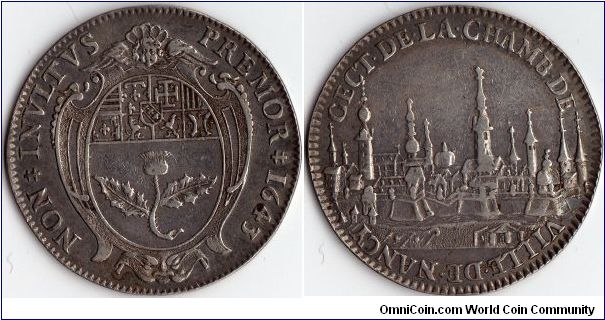
Here's another `city view' silver jeton, this time of the town of Orleans dated 1735. It was issued for the guildsmen of the city and again is more usually found in base metal.
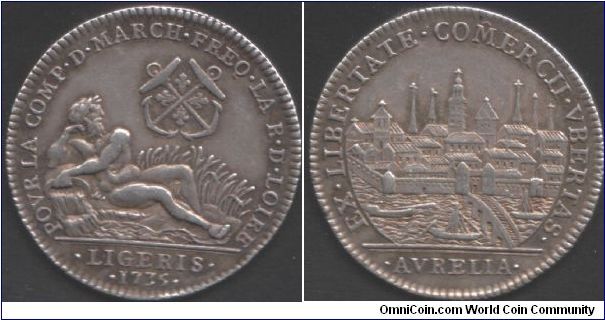
Here's another later date (1760) silver jeton for Orleans
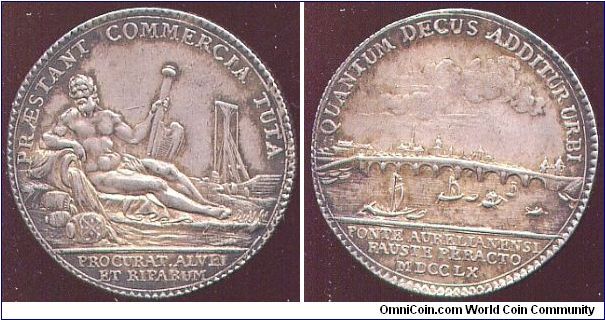
....and now for Paris. Here's the earliest one I have in silver of a view across the Seine towards Chatelet / Notre Dame.It is dated 1682 and was issued for M'sieu Pomereu for his third term in office as the Lord Provost of Paris (Mayor).
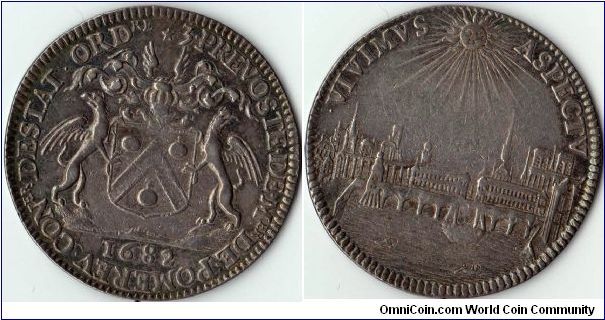
-
Ken bresset's example is a bit late on the chain of these `shield' type jetons.
For example here's one with the exact same design which predates Ken Bresset's example by some 24 years.
http://www.cgb.fr/monnaies/jetons/j18/gb/m...7&nbfic=725
Here's another from a different region of France showing the `shield' in action

http://www.cgb.fr/monnaies/jetons/j17/imag....html?depart=21
"There are quite a few `out there' Skully"
 .......but there's nothing `ufo' about any of them.
.......but there's nothing `ufo' about any of them.Ian
-
Hello all. I am looking to purchase 1600s French Jetons that depict UFOs. Does anybody have any? I have been looking for over a year to no avail.
If anybody has some, please post pictures. Will pay cash. Thanks-

These are currently in unusually high demand....and all because a celestial shield has been seen by one or two cranks to be examples of `UFO's'.
Jean Elsen (Belgium) recently had a couple in his catalogue. I don't have one of the `shield' type but I do have a couple of examples of the UFO tracking station at Lyon in France if they would be of any use to you. I can let you have one for the princely sum of one arm, one leg, and one left testicle.....or some more suitable form of financial settlement

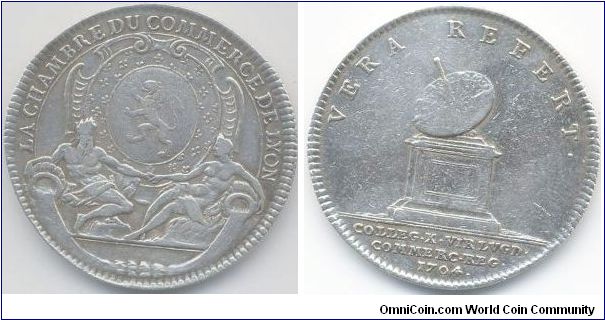
-
Since my initial post I discovered that there were at least two different busts of Louis XV used for the jeton issued in 1756. The normal jeton issued for `La Marine' bore the bust of the Grand Admiral de France, in this case Louis Jean Marie de Bourbon, Duc de Penthievre who was the Grand Admiral of France at the time of the French victory at Port Mahon in 1756. I have been fortunate to have managed to find and purchase one of these.
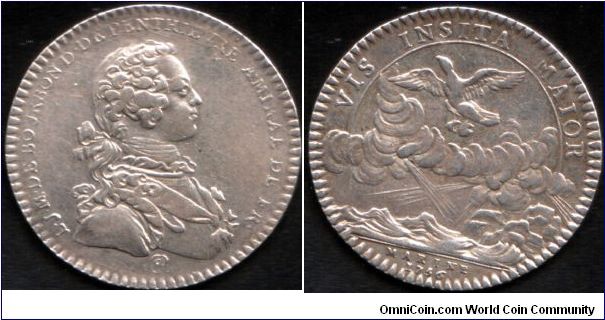
I now realise that I should have posted the initial post in the exonumia section. Any way of having it transferred over there?
Ian
-
Very interesting pieces Bill, and a great insight as to their `raison d'etre'.
Ian
-
here is the other one
This one is listed in D.R. Krause's book as no.184 `Cantonal Shooting Festival at Ebnat-Kappel under St Gallen. There are no mintage figures given, but it appears that it was only minted in silver and bronze. Diameter 45mm and the engraver is Bovy.
-
Her are 2 of mine . they are proably 2 of my favorite pieces of anything in my collection i see Ian has the same one and jeggy has the other one can you all give me more info Price, cataloge number, mintage etc. i may start to stream line my collection and add some more of these
This `Frauenfeld' one is listed as no. 228 under the Canton of Thurgau in Delbert Ray Krause's `Swiss Shooting Thalers and Medals' (1965). There was 119 minted in gold, 5,760 minted in silver, 4,500 minted in bronze, and 24 minted in aluminium. The diameter is 45mm and the engraver is Hugues Bovy. I can't give a value for these but if you check on ebay ....who knows.
-
I tried to email Kyle about these when he came out with the bimetallics back in October, his email went down and I gave up

Check for a PM on this.
-
I wanted to get those, but never heard from Kyle regarding them


I truly recommend that you keep trying Dave. I'm rarely enthused about anything as much as I am concerning that bimetallic. Persistence is not futile.

-
Let me introduce you to the handywork of a certain Kyle Mutcher, the owner of `Four Corners Coin and Currency' Winnipeg, Manitoba, Canada.
I know Kyle via our joint participation in the usenet newsgroup `rec.collecting.coins'.
Rec.collecting coins is the very first newsgroup to have issued its own token `coinage'. This commenced in 2002 with a crown sized `Ember' token, and was followed by a few more in the same vein. However these `ember' tokens are not the subject of this posting, but rather they are mentioned as a historical backdrop.
In 2004, Kyle came up with the idea of producing a hand struck silver token for the newsgroup. First he found old silver, melted it and moulded it into a ball which was then hammered flat into a disk. it was then placed between two hand engraved dies and struck with a twelve pound sledge hammer.
Here is an example of the 2004 `Spark' token:
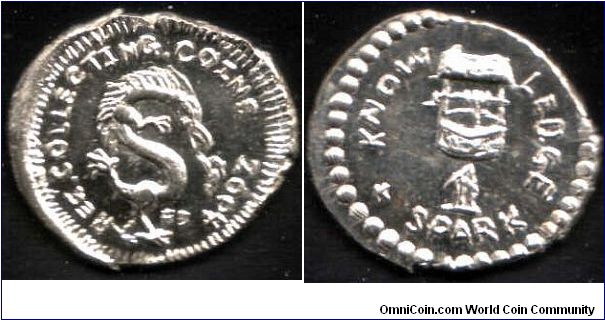
Kyle has since produced different designs as `trade tokens' for his customers redeemable at his shop. I have a few of these that are certainly worthy of mention, but I will stick with his rec.collecting.coins tokens for now.
In 2006 he produced another silver `Spark token' and a bimetallic (copper outer / brass inner) `Stick' token in response to requests from fellow members of the group.
The `Spark' has (obverse) the RCC dragon perched on the earth, with wings outstretched , and (reverse) a small village reverse representing the sense of `community' held by many of the collectors in the group.
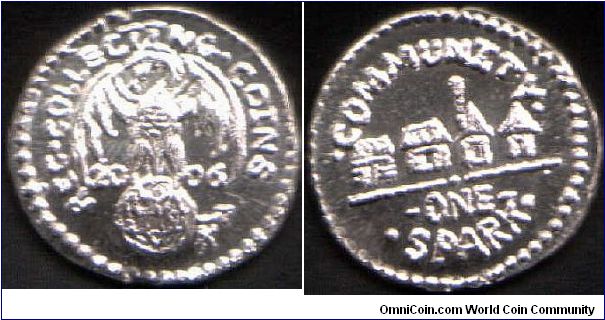
However, I think Kyle has really excelled himself with his `I Stick' bimetallic. Bear in mind that he (and his father Otto) have done everything from making the blanks, engraving the dies, and striking the `coins'.
The `Stick' shows the RCC dragon clutching the Earth with his claws (obverse). Reverse, Moneta (Goddess of Money) is holding a balance in her right hand, a stick in her left, while at her feet is a dead horse. This depicts the balance of reason and persistence of opinion in the newsgroup (typically expressed as `flogging a dead horse'). This token is very three dimensional, and a work of true art (IMVHO). Much kudos to Kyle! My scans of these little gems certainly do not do them adequate justice.
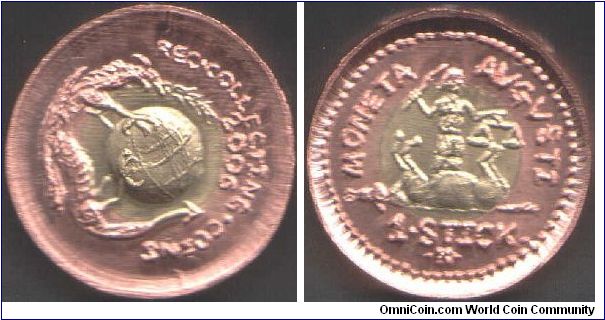
-

When I was a kid I bought an 1822 Large Cent at a state fair once, for a few weeks it was my oldest dated coin until I got a well worn but discernable 1817 Large Cent, a couple of years later I bought a 1797 Large Cent, then went downhill from there after getting into foreign coins.
So far, this coin that I purchased probably 15 yrs ago remains my earliest dated coin from coins dated in the Christian era, a 1508 Hungarian Denar minted during the reign of Wladislaw II Jagiello of Hungary(1490-1516) Hungarian denars because of their great quantity remain the easiest and most affordable way to obtain a very early dated coin.
Please post a pic of your earliest dated coin, perhaps someone has something older than this.
Hey Dave, I don't have a Hungarian denar that is older, but I have one that is just a year younger.

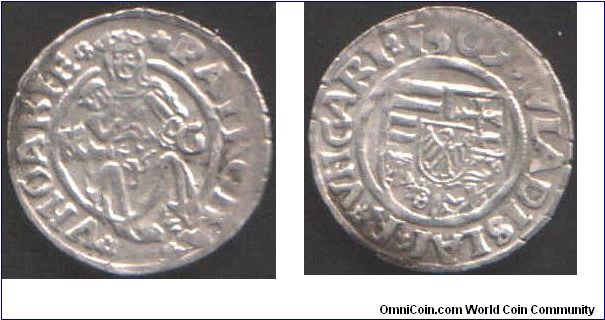
-
Here's a few examples of French `emergency' money or `monnaie de necessite' as it was called.
The first two were issued during world war I. The first is a 10c from Marseilles dated 1916, the second a 10c from Besancon dated 1917.
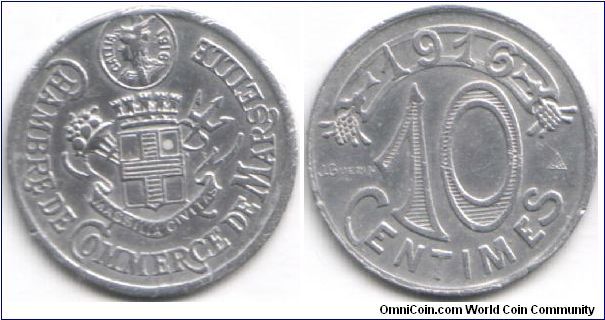
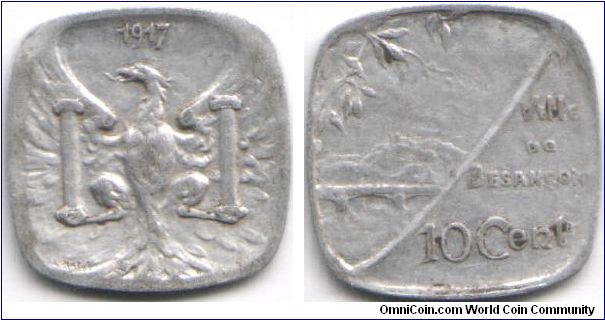
The next five were all issued post war and in order of appearance are Nice 10c 1920, Rouen 25c 1920, Eure et Loire 25c 1922, La Rochelle 25c 1922, and an Evreux 1 fr 1922.
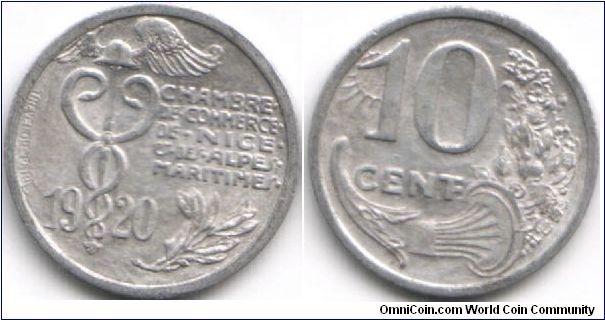
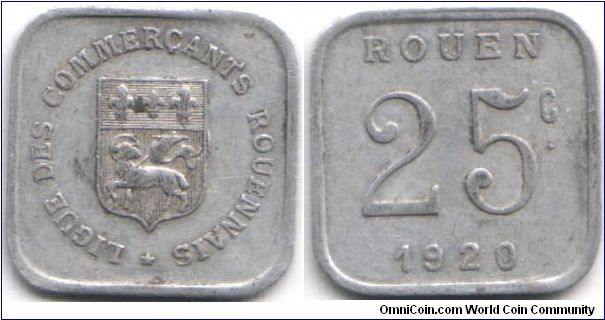
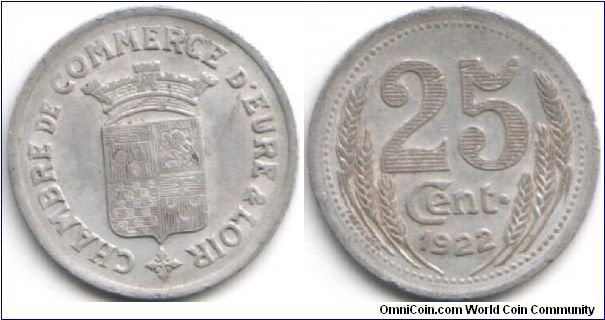
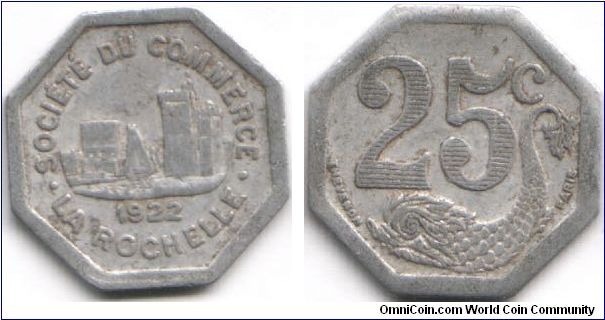
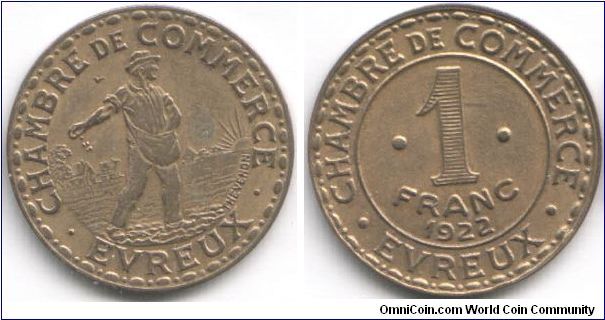
-
The reason behind the issuance of these coins is fairly straight forward but requires a lengthy explanation. I'll try my best.
After World War I the french economy was in dire straits, as was that of Germany and most other european countries. There was a general lack of coinagewhich in no small part was due to France doggedly sticking with the silver standard in issuance of its 50c, 1 fr and 2 fr coins up to and including 1920 due to the prevailing mantra of the time `Le bosche payera!' (the germans will pay!). They were of course relying on Germany making good on demands by the allies for war reparations, which frankly were very unrealistic. Germany simply did not have the resources to make good on expectations. Hence no silver and coin shortages. Although some coinage was being produced it was not sufficient to satisfy the demand throughout the land.
This led on to the emergence of private tokens to facilitate trade locally.Then there was stamp money (monnaie de timbre) followed by numerous local Chambers of Commerce issuing their own token coinage (or `notgeld'). The latter were (with a few exceptions) usually small denomination aluminium coins for 5c, 10, 10c, 25c and 50c and only valid on a very local basis. It forms a whole collecting area in its own right. I've a few of these and will scan them sometime this week.
However, although linked to the history and raison d'etre of the `bon pour' Mercury coinage , the brass `bon pour' coinages (using an engraving by Domard as its obverse) were official. The National Chamber of Commerce agreed with the government to issue nationally acceptable 50c, 1fr, and 2 fr coins. However because of the political sentiment prevailing mentioned previously (le bosche payera) and the belief that France would return to the use of silver coinage, the brass coinage was always seen as only being an interim feature and that these would indeed be replaced /exchanged in due course with silver. Hence the use of `bon pour' (good for).
As we know, France never did return to silver coinage and as such they remained in circulation until they were eventually demonetised.
The brass `bon pour' 50c was issued between 1921 -1929, the 1 fr and 2 fr between (1920 -1927). All bear the same obverse design .
There are some variations which make for interesting collecting (including partial die fills with the engravers name and dates partially obliterated; open 5's closed 5's open 4's closed 4's, overstruck dates etc). It's a relatively cheap and rewarding way to start learning about die states and variations.
The later dates for the 1 fr and 2fr of this type are very much sought after and can cost an arm and a leg in higher grades.
Hope that provide you with some insight.
-
 Well, I was hoping the pictures would have helped w/the identification of this coin, medal, token ??? etc., but........ However, I would like to say, Thanks because I've learned alot about coins from your Forum and I hope to continue building my small collection.
Well, I was hoping the pictures would have helped w/the identification of this coin, medal, token ??? etc., but........ However, I would like to say, Thanks because I've learned alot about coins from your Forum and I hope to continue building my small collection.Sincerely,
AbbyNrml

Charles IX was made king of France at the ripe old age of 10 following the sudden death of his brother Francis II. Charles ruled from 1560 to 1574 (mainly under the tutelage of his mother Catherine De Medici.
In 1570 (november 26th) he married Elisabeth of Austria, (daughter of Maximillian II, Holy Roman Emperor.
As to your item, I can't tell from the images what size the item is, what the metal is, and whether or not it is from the period concerned or a modern made item. Sorry.
However, it in all likelyhood commemorates the marriage of Charles IX and Elisabeth in 1570.
If it is circa 27 - 28mm diameter and silver, then the likelyhood is that it is a presentation piece made for the royal household staff and dignatories of that time. If larger, then it probably falls into the `medal' category...about which I know even less. ;-)
-
My thanks go to scoutjim99 for his excellent tracking skills!!
He has managed to successfully attribute this coin to being a copper dirham of Nasir al-Din Artuk Arslan atabeg of Mardin (1200-39 AD), minted at Mardin in 620AH (that is, 1223 AD)
The obverse is the bust of the Roman Emperor Claudius.
The reverse of the coin cites Ayyubid al-Kamil (1218-38) and caliph al-Nasir (1180-1225).
Apparently it is referenced in Stephen Album's "Checklist of Islamic" as A#1830.7, with a rarity rating of "scarce" (not really rare, but not common either).
scoutjim99 managed to find the coin on Jim Robert's site (tenth coin down on the page)
http://users.javanet.com/j/-/j-roberts/art.htm
scoutjim99, my hat is off to you.
 Take a bow.
Take a bow. 
Ian
-
If you let me take a copy of your photo I can post it some where else, to try to get you some info. Let me know
Brilliant. Copy to your hearts content as far as i'm concerned.
Ian
-
Any positive ID of this coin would be appreciated. It's copper, roughly half crown sized and i'm led to believe it is of Urtuk Arslan of Mardin (1200 - 1239 AD).
Mediaeval Islamic coins are not exactly my hottest area of expertise so i'm lost on this. I had thopught that a portrait on an islamic coin was a no-no though (?) So i'm even more lost.....
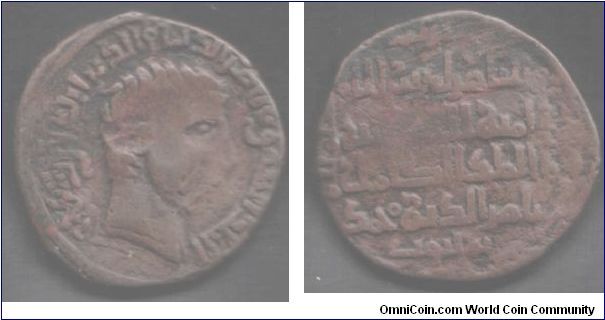
-
-
A few years back I won a competition on r.c.c. The prize was a 1986 proof set which this coin is from.
The competition went along the lines of `there's an Australian coin that provides positive evidence that there are aliens hiding right here on earth. Which coin is it?'
Well, this is the coin. if you look very closely at Mrs Echidna's nose you'll see the alien in hiding.

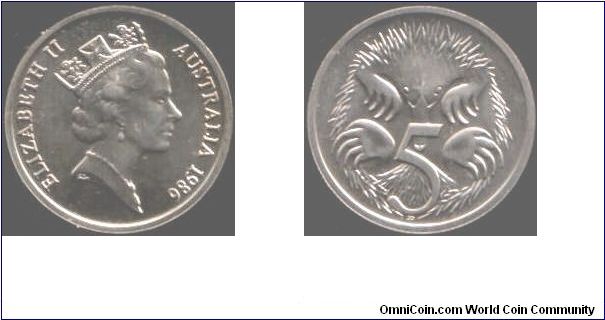
-
Here's the `blue' one.
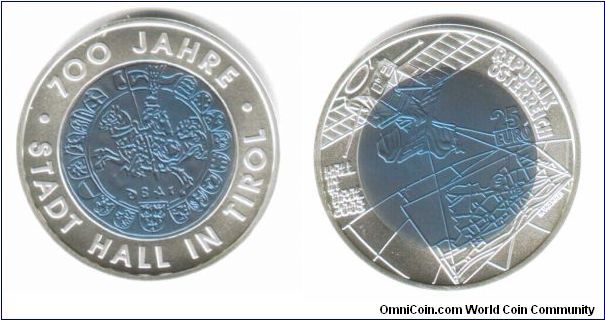
-
Not only that - it also had a very interesting mint/die theme. The later ones are OK but not that neat in my opinion.
Christian
I was lucky. I managed to get hold of two of the first issue. I kept this up with the second and third, but decided to call a halt on my Austrian niobium collection when I saw the khaki coloured one. To me it looks like it has an alu/bronze centre. Mimicing a base metal doesn't exactly show off the potential of niobium to its best advantage IMHO.
Ian
-
Very nice `potins' indeed.
Fascinating subject area, and one which I have avoided (to date) because I can't afford to have any more `interest areas'. While I still have a goodly few coins on my `hammered's' list to acquire I can see that it is going to be a struggle for me to stay away from these little bitties for much longer......
Bill, not all that many people will know what a `potin' is, let alone where they come from. If you could say a few words concerning same it would (IMHO) add to the `backdrop' for these particular ancient pieces.
Ian
-
Nice coins Jorge. I keep looking into the flames now on your Sassanians......

Out of interest how does the weight of the top decadrachm compare with the real McCoy? It looks to me that the word `copy' could be easily obliterated. It looks a lot more realistic than the one someone tried to foist off on me as the real McCoy a couple of years back.


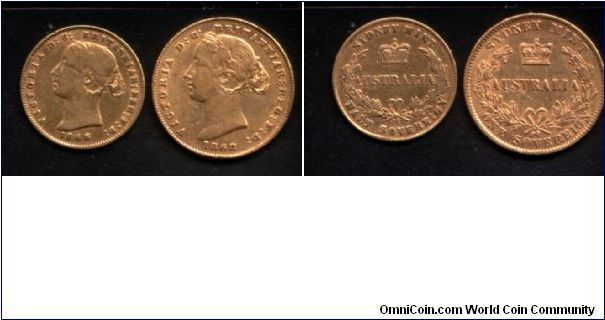
How Far Back Can We Go??
in Coin Forum
Posted
et voila! a 1695 40 shillings Scots